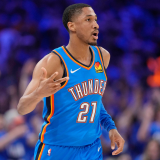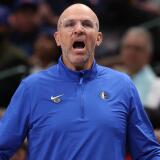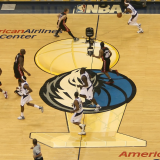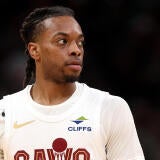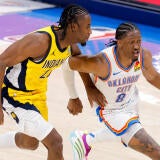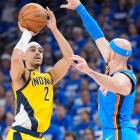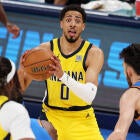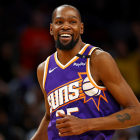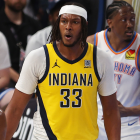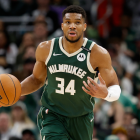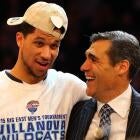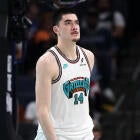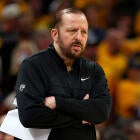
Giannis Antetokounmpo trade: What should Bucks look for if they move one of NBA's elite players?
The Bucks are facing one of the most important decisions in franchise history
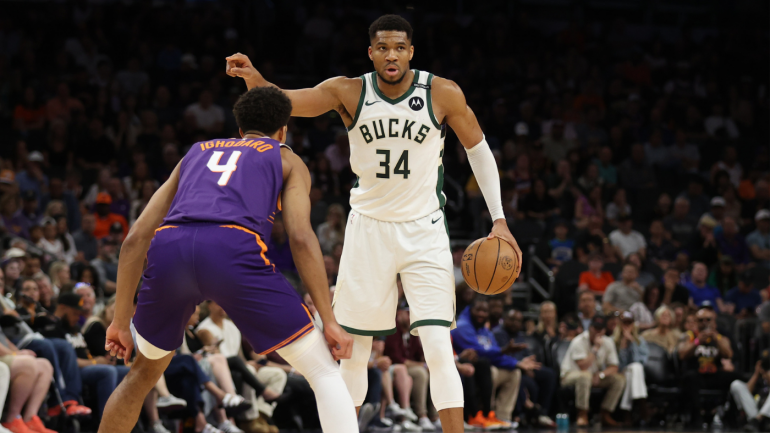
When a superstar gets traded, there's usually a template for the return package. A significant amount of draft picks are usually involved. Hopefully a promising young player is the centerpiece. Older players are usually in the mix as well, if only for salary-matching purposes. The hope, generally, is that the assets gained in such a trade can facilitate a reasonably quick turnaround and that the team giving up the player in question can start winning again within a few years.
But as the reality of a possible Giannis Antetokounmpo trade sets in, the Milwaukee Bucks face a far grimmer future than most teams giving away All-NBA players. They don't have a particularly easy path to a quick rebuild. They don't control their own first-round pick again until 2031, so they gain nothing by being bad. They don't have a single player on their current roster who projects as a long-term starter for them. They also play in one of the NBA's smallest markets. They are facing a harsher business climate than teams in more glamorous cities would here. Whether it's the proper basketball motivation or not, they still need to sell tickets.
The stakes here are higher for Milwaukee than perhaps any other team trading a star in history. He is their only significant chip left. What they get back for him basically has to be enough to sustain this team until at least the end of the decade, if not longer. The immediate future of this franchise hinges almost entirely on what they seek out in return for the best player in franchise history.
Which begs the question... what exactly should they be looking for here? What will they be looking for? Below, we'll cover all of the possibilities, explain why exactly they make sense for the Bucks, and come up with a few teams that check those boxes.
Young players
This is the obvious play. Consistent winning requires at least one All-Star-caliber player. The Bucks are never going to attract one in free agency. Trading for a veteran is prohibitively expensive unless you're willing to take a substantial health, age or financial risk. The Bucks could trade for draft picks and try to pick one. Drafting your own star is optimal because it not only assures the longest possible timeline with that player, but hopefully engenders some degree of loyalty. Drafting Antetokounmpo is responsible for basically all of Milwaukee's success over the past decade. Of course, if drafting stars was easy, Antetokounmpo never would have fallen to No. 15 overall.
Trading for young players is the middle ground, a chance to bet on prospects that you like, but with a bit more certainty as there have already been glimpses of what they can do as professionals. The upside is slightly lower than it would be with draft picks. Trading for an established NBA player usually means they're either close to a market-rate contract or already on one, whereas a first-round pick gets four years of cheap team control. But, remember, this is a business. Draft picks don't sell tickets. The Bucks need some measure of certainty, someone they can put on the floor and sell to their fans as a reason to both come to games immediately and to have some optimism in the franchise's long-term outlook.
So who are the players we're looking at here? The starting point would be the two Texas teams. If Houston wants Antetokounmpo, the Bucks will almost certainly ask for Amen Thompson or Alperen Sengun. If San Antonio wants to get into the mix, Rookie of the Year Stephon Castle figures to be involved. One of the benefits of trading a player as good as Antetokounmpo, though, is that the overwhelming interest he figures to generate gives the Bucks access to a much wider pool of young players than a normal star would. They're trading a two-time MVP here. If they decide that there is, say, a young point guard on the Magic that they are certain will be an All-Star, or a power forward in Atlanta that has All-NBA upside, they can attempt to redirect assets acquired in this deal to that third team to get the prospect they really want. They don't need to limit themselves to just what the interested parties have.
That puts a lot of pressure on Bucks general manager Jon Horst. Think back to Oklahoma City's 2017 trade for Paul George. People thought the Pacers were crazy to make such a big bet on Victor Oladipo and Domantas Sabonis. Both became All-Stars. Somewhere out there in the NBA right now is a potential franchise player that the Bucks, thanks to Antetokounmpo, can afford. His promise hasn't manifested itself -- if it had, he wouldn't be available -- so this will be the greatest possible test of Horst's ability to identify talent. This trade is his chance to find future diamonds in the rough as Indiana did back then, and for Milwaukee's sake, he'll absolutely have to.
Veterans
Would I necessarily advise the Bucks to trade Antetokounmpo for players in his age range? No, but optimizing for long-term championship pursuits is not necessarily every team's priority. For Milwaukee, there's something to be said for the idea of just being decent for a few years and figuring things out.
The obvious financial motivation there is ticket sales. You can run a sustainable business winning 40 or 45 games. If you're looking for a basketball motivation though, there is a pretty compelling one. Tanking is off of the table for the Bucks without their own picks. Last offseason, the Nets started the trend of trying to trade for control of your own picks back in order to regain the ability to tank. There is, however, another way to regain control of your own draft capital if you've given it away: you can just wait for it.
As dull as those 40-45 win seasons might sound, they're a way to buy time. If the Bucks don't want to do anything hasty, they can play for a higher floor and a lower ceiling, slowly pay off their pick debt without giving up top selections, and then try to reset more fully closer to the end of the decade, once control of their own picks is back within reach. It's not the sexy choice. It's the one certain owners will always be tempted to make.
So let's say this is where the Bucks go. Who are our viable trade partners? Cleveland stands out following its second-round loss to Indiana. Evan Mobley and Donovan Mitchell are probably both off-limits, but Darius Garland and Jarrett Allen are both former All-Stars and still reasonably young. The two of them could form the centerpiece of a compelling "stay somewhat competitive now" package. Speaking of Indiana, whoever loses the Eastern Conference finals makes some sense as well. Maybe it's a Karl-Anthony Towns and Mikal Bridges-centric offer, or perhaps Pascal Siakam and some of Indiana's other supporting pieces. Either way, the Bucks could make a trade like this and still probably make the playoffs for the next few years.
Cap relief
Again, probably not what fans are looking for, but realistically, this is something owners tend to care about. The Bucks have paid the luxury tax every year since their 2021 championship season. They are probably going to pay Damian Lillard $54 million not to play for them next season and then $58 million to play substantially worse for them the year after that. They would surely favor a deal that offers them relief from that contract. That's probably unrealistic, but escaping the last two years of Kyle Kuzma's contract, worth nearly $43 million in total, is feasible.
If cap relief is a major goal for the Bucks, the Nets are our winner here. They are the only team in the NBA projected to have cap space this offseason, but if they were to do everything in their power to maximize that space, they'd be looking at nearly $80 million in room. They can afford to take Lillard if they need to, and without a premium young player or top draft pick to send back, this might be their only way to convince the Bucks to deal with them.
More likely, they find a way to turn the Kuzma contract into someone's expiring deal in the trade. That's much more palatable. A number of lottery teams have expiring deals to dangle and would happily take on an extra year of money both to get a draft pick and to potentially rehabilitate Kuzma's value. Hey, he was good enough to get this contract once upon a time. Maybe in the right situation, he could be that good again.
Immediate draft picks
There's inherent risk in trading for any future draft picks. You don't know where they'll fall in the order. The team responsible for determining where they wind up has no incentive to lose, so outside of extreme cases, they're usually not very high in the draft. The obvious way to sidestep this risk is to trade for picks in the upcoming draft. The lottery has already happened. Everybody knows where they're picking in 2025.
If the Nets trade for Antetokounmpo, the No. 8 pick is going to be in the deal. If Houston gets him, No. 10 will head to Milwaukee. But those are supporting elements to a trade like this. The real prizes are at the top.
Dallas has already reportedly decided to take Cooper Flagg No. 1, so the Mavericks are out. The Spurs at No. 2, however, are probably thinking long and hard about an Antetokounmpo pursuit. They have Victor Wembanyama and De'Aaron Fox already. They could win the 2026 championship with Antetokounmpo, but still have more than enough depth both in terms of young talent and future draft picks to keep winning after Antetokounmpo's prime. It makes potential sense, therefore, for the Spurs to include that No. 2 pick (which will presumably be Rutgers point guard Dylan Harper).
Even if they don't include it, Harper's presence makes it far easier to swallow trading Castle, the reigning Rookie of the Year. They're each insurance for losing the other, and frankly, they don't fit together anyway. Castle is a complete non-shooter at this stage. He's not going to be able to function on an Antetokounmpo offense, and even if he could eventually, it would mean controlling the ball more than he could with Harper and Fox in place. One of them probably has to go, whether it's in this trade or another.
So San Antonio makes clear sense at No. 2. What about Philadelphia at No. 3? There's a drop off after Harper, but Ace Bailey and VJ Edgecombe have star potential as well. Paul George could be their matching salary, and while he obviously isn't the player he once was, he's a big enough name to sell some tickets, especially once Lillard comes back in a year. With Jared McCain and several future draft picks involved, this isn't a terrible package. It's just a matter of how much the 76ers are willing to bet on Joel Embiid's health. If Embiid is healthy, he, Antetokounmpo and Tyrese Maxey can win a championship. Philadelphia probably emphasizes its future, just given the health risks both George and Embiid carry, but Daryl Morey is aggressive enough to consider anything if the price drops into his range.
Their own future draft picks
As we've covered, a team without its own draft picks can't tank. However, a team giving away a player as good as Antetokounmpo probably wants to tank. They're generally going to be bad anyway, so they might as well get good young prospects out of it. Last offseason, the Nets pioneered the concept of trading for their own picks back when they swapped several future Phoenix and Dallas picks to the Rockets to return most of the remaining outlying picks from the 2021 James Harden deal. In theory, it would behoove the Bucks to do the same.
It's going to be a lot harder for them, though, because their picks are separated. Houston had full control of every outlying Brooklyn pick. Milwaukee's case is more complicated:
- New Orleans has unprotected swap rights with Milwaukee in 2026. They also get Milwaukee's pick in 2027 if it lands between No. 1 and No. 4. This is from the 2020 Jrue Holiday trade.
- Atlanta gets Milwaukee's pick in 2027 if it falls between No. 5 and No. 30. This is from last offseason's Dejounte Murray trade.
- Portland has unprotected swap rights with Milwaukee in 2028 and 2030 along with outright control of Milwaukee's pick in 2029 thanks to the 2023 Lillard blockbuster.
Portland controls the biggest supply of future Milwaukee picks -- three out of the five in total -- but they're also the three latest picks. That puts the Bucks in a difficult position. They could try to trade for those picks back, but to be bad enough to maximize them, they'd probably have to plan to be bad in 2026 and 2027 as well. That not only means suffering the embarrassment of potentially giving New Orleans or Atlanta very good picks, but also trying to be bad for five straight years. A small market like Milwaukee isn't going to want to do that.
Also remember: a team that controls your picks has incredible leverage over you. When the Nets traded with Houston last summer, they effectively traded four significant draft assets for two. Therefore, if the Bucks wanted to get three picks back from Portland, it might cost a sizable chunk of their Antetokounmpo return.
The Pelicans and Blazers aren't going to get Giannis themselves. They're not good enough to justify such an acquisition. Atlanta might sneak into the conversation, but won't be a favorite. However, all three will probably be eager to facilitate a deal. If New Orleans in particular can extract value to participate, it probably should. Remember, the Pelicans just had the NBA's fourth-worst record. They're probably going to be swapping out a reasonably high pick, and while there's a ton of value in, say, jumping from No. 6 to No. 3, the odds of such a high-end payoff coming are minimal. If the Pelicans can get something good to give the Bucks control of just next year's pick back, so Milwaukee can tank for a year before trying to win again, it makes sense to do so.
Someone else's own future draft picks
Say you trade Antetokounmpo to someone for all of their own future draft picks. Suddenly, at least the first few picks become significantly less valuable because Antetokounmpo is now on that team. His teams are usually going to be quite good, so their picks will be low.
This is what the conversation surrounding star trades often gets wrong. Quantity doesn't matter nearly as much as quality. Who cares if you get four picks if all of them are in the 20s? Imagine the Bucks trade Antetokounmpo to the Spurs. The Spurs have a 21-year-old Victor Wembanyama. The latest possible pick any team can trade is seven drafts into the future. This summer, that means a 2032 first-round pick. Wembanyama will still be in his 20s then. Spurs picks, therefore, have very little value.
So ask yourself this: who's going to be old in 2032? Or, hopefully, sooner? What teams are so desperate to win right now that they might be prepared to mortgage their potentially dismal futures like the Bucks once did for Holiday and Lillard just for the chance to briefly win with Antetokounmpo on their team. Ladies and gentlemen, may I introduce the Golden State Warriors into the discussion. I've covered their possible pursuit of Antetokounmpo in more depth here, but the short answer here is Stephen Curry will be 44 in 2032, so those deep future Warriors picks figure to be quite valuable.
Fully separated draft picks
When I tracked it last offseason, nearly one-third of all tradable first-round picks in the next seven drafts had been traded either outright or through swap rights. That number gets bigger every year as more and more teams throw draft picks into blockbuster deals. Picks that have already been traded once are uniquely valuable because they are in no way tied to the player getting traded. Basically, if you're getting picks that have already been traded, you don't have to worry about Antetokounmpo making them less valuable because he isn't playing for the teams those picks are coming from.
Houston, by virtue of its control over Phoenix's picks in 2027 and 2029, and Brooklyn, through New York's picks in 2027, 2029 and 2031, are our standouts here. San Antonio still controls some outstanding picks, but dealt a few in the Fox trade at the deadline. While they won't trade for Antetokounmpo themselves, don't rule out Utah involving itself in this trade in some way. The Jazz control plenty of these picks themselves, and as they showed with their deadline deal for Phoenix's 2031 pick, they're eager to step in and facilitate moves if it means getting draft choices they deem to have higher upside. If nothing else, the Jazz are likely open to diversifying their portfolio of picks. It never hurts to hedge your bets.
So what does a perfect trade look like?
The Bucks are trying to do a lot of things here. They're not going to accomplish all of their goals, so as they prioritize, here are the ones that I'd deem most important.
This trade does not work without at least one (ideally two) player under the age of 25 with All-Star upside. Aside from giving the fan base hope, these are also the players who will be around long enough for the Bucks to wait out their outstanding pick debt. Effectively, these players get them back to neutral at the end of the decade, and hopefully they do a good deal more. These players can be highly coveted young stars (Sengun, Thompson, Castle), they can be top draft picks this year (Harper, Bailey, Edgecombe) or, if Horst is feeling particularly aggressive, they can be players that come from teams we aren't expecting that he deems especially promising. Fortunately, he just signed a contract extension, so he doesn't have to avoid risks for the sake of job security.
Salary should be the least important component of the deal. The Bucks are never going to be free agency players, and they have no youth that's going to need pricey extensions yet. Basically, their money has to go somewhere. If that means taking on bad contracts to maximize asset return rather than dumping their own deals, so be it. This is something to consider in direct negotiations, but it's also something to consider as a secondary maneuver. Say the team acquiring Antetokounmpo can only match money with a good player on an expiring contract. It makes all of the sense in the world for the Bucks to turn around and dangle that good player to teams trying to offload long-term money if they can net extra assets out of the deal. If Philadelphia wants to dump George, take him. Bradley Beal probably doesn't want to be a Buck, but hey, it's worth the ask if Phoenix will pay enough.
As far as the picks the Bucks get go, they'd likely want a mix of choices from a number of sources. Out of their own picks, 2026 is the one they should target most. It's the one most directly in their control, and it's the one that requires the least overall tanking. Plus, with New Orleans likely sensing that next year is a rebuilding year for them anyway, the cost for dumping those swap rights might not be especially high.
As far as external picks go, the Phoenix picks from Houston should be at the top of their list. Remember, the 2025 Suns pick just came in at No. 10. This was the version of their team they expected to actually be competitive. Things are only going to get worse in Phoenix as the team gets older and the aprons become more onerous, and if nothing else, having those Suns picks gives the Bucks a bit of leverage to hold over Phoenix's head in a year or two if the Suns decide to trade Booker. Brooklyn's picks from New York and San Antonio's picks from Atlanta, Minnesota and Sacramento all hold some appeal as well.
So put all of this together and, unsurprisingly, the Rockets and Spurs are obviously preferable trade partners. If Antetokounmpo does decide to stick his thumb on the scale though, there would be worse fates than, say, getting control of the post-Curry Golden State picks. Ultimately, the Bucks should view nearly the entire league as plausibly available in a deal of this magnitude. There are only 15 multi-time MVP winners in NBA history. Antetokounmpo is one of them, and he is still in his prime. If someone wants to get him, the Bucks should exert every ounce of leverage they have to secure the best possible deal. If that means forcing a trade partner to go get them someone specific from an otherwise uninvolved team, then so be it.
![[object Object] Logo](https://sportshub.cbsistatic.com/i/2020/04/22/e9ceb731-8b3f-4c60-98fe-090ab66a2997/screen-shot-2020-04-22-at-11-04-56-am.png)


